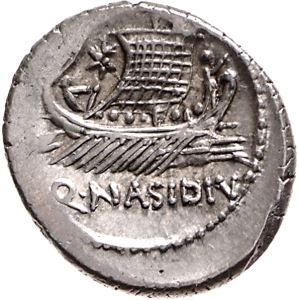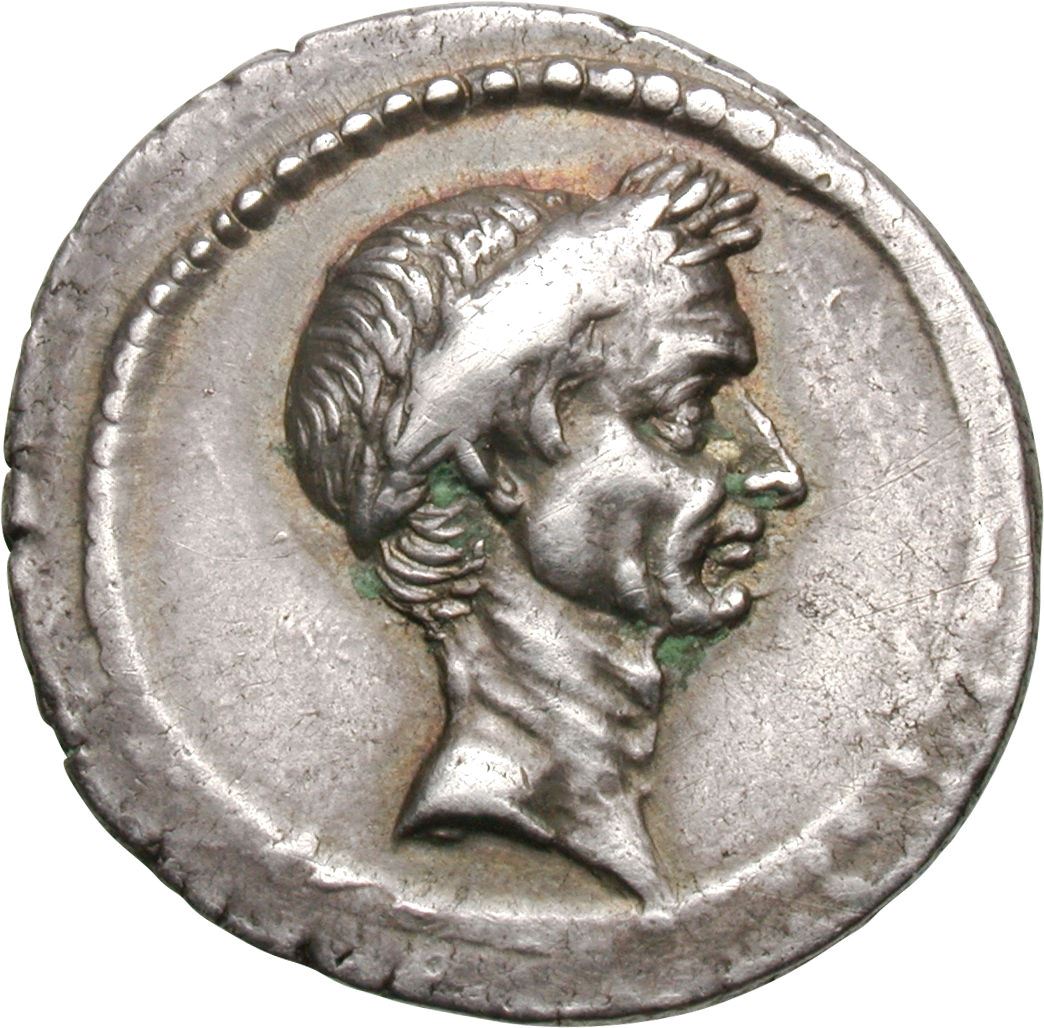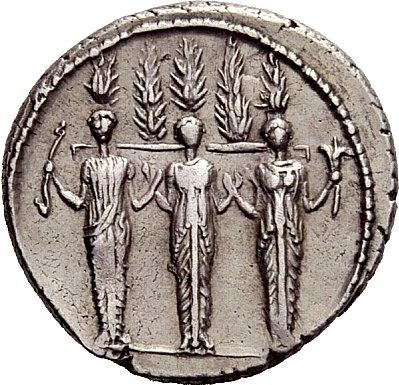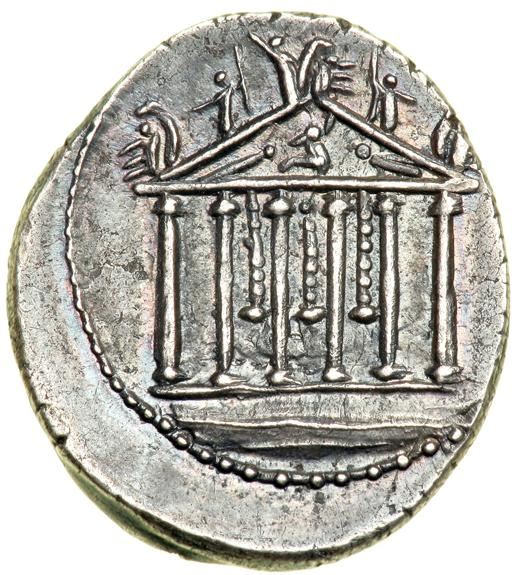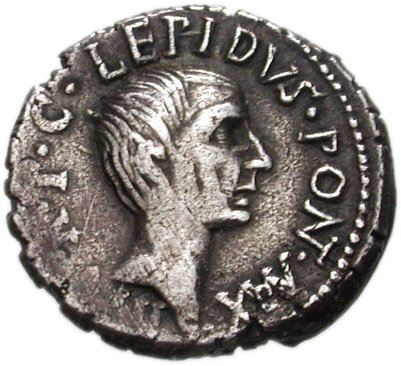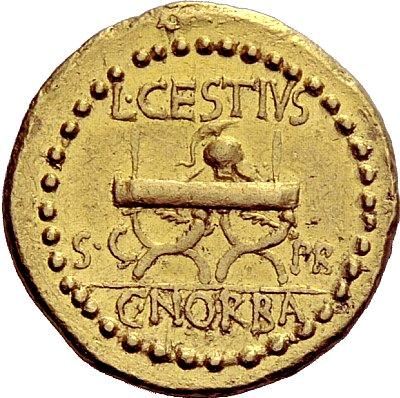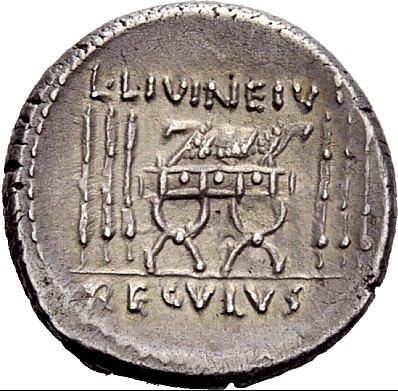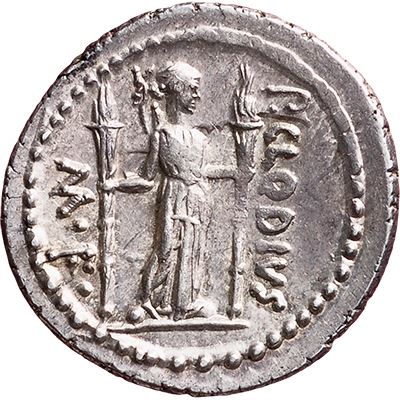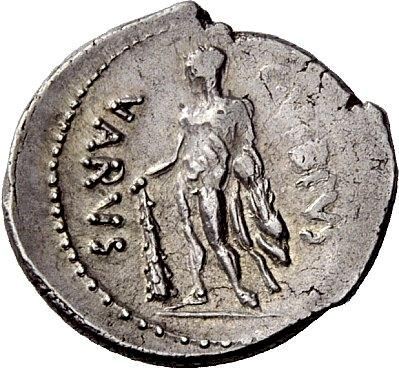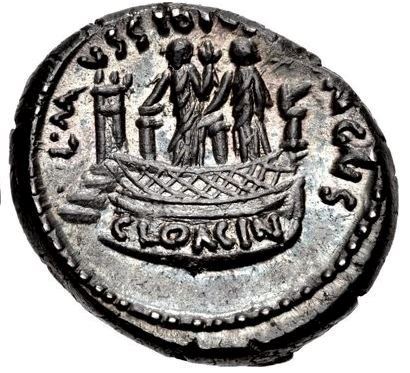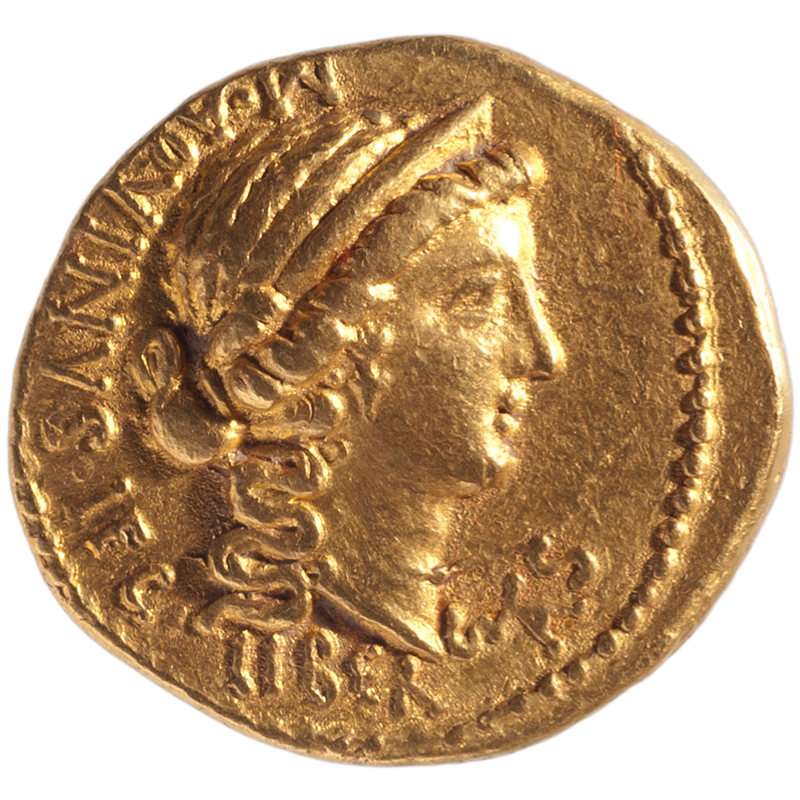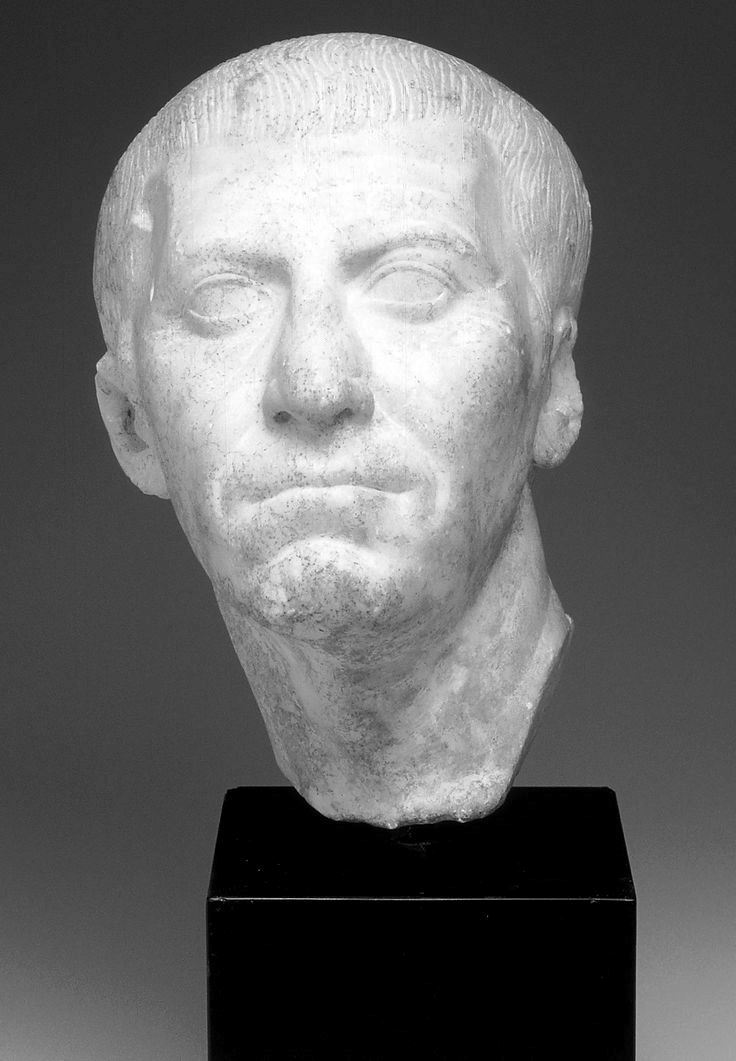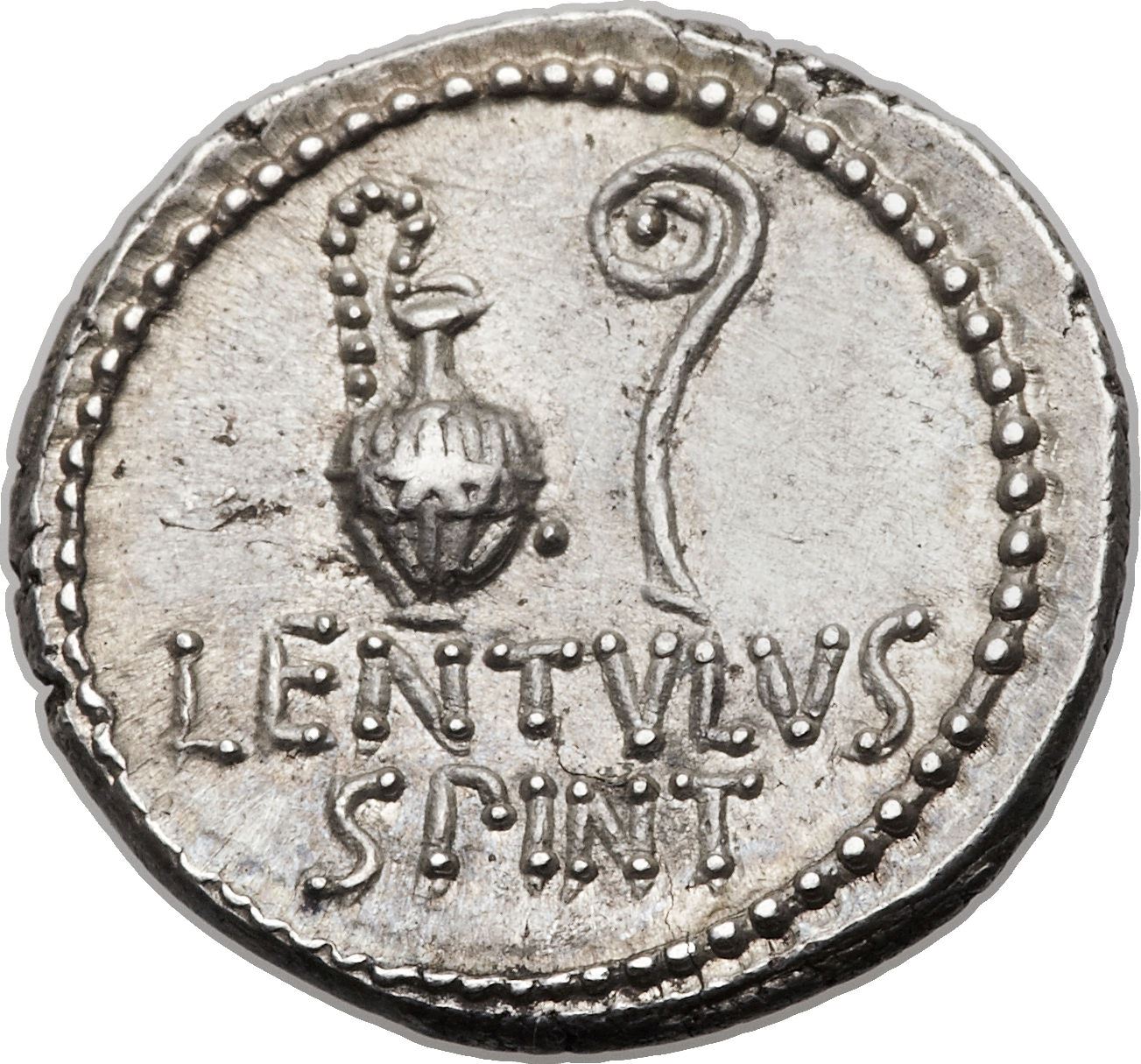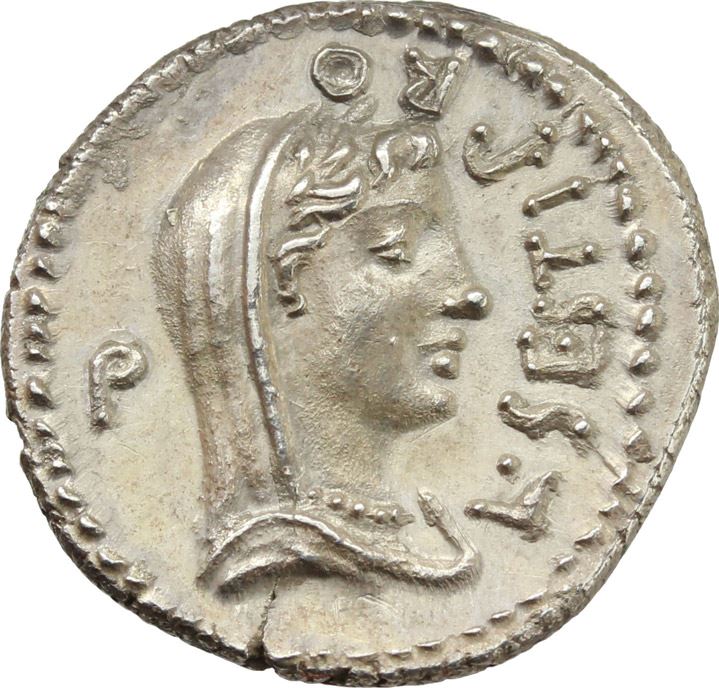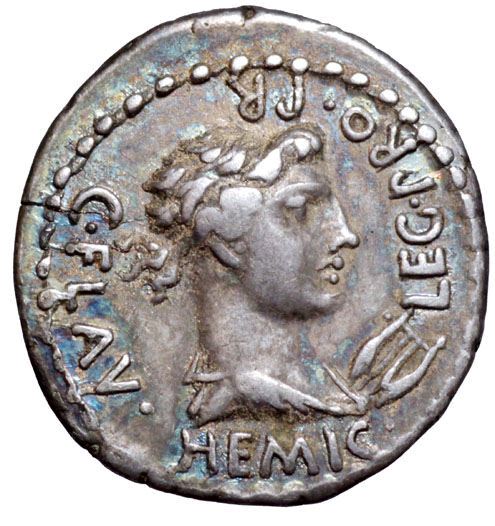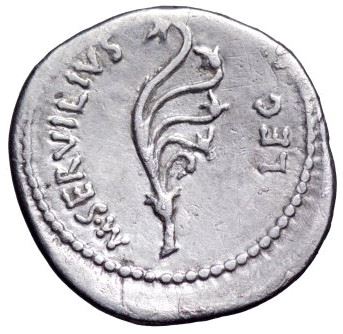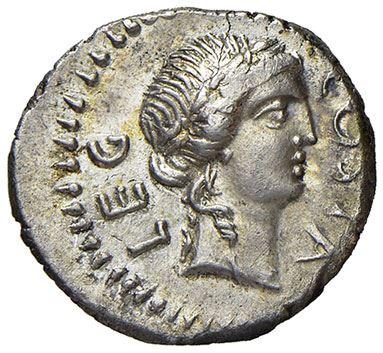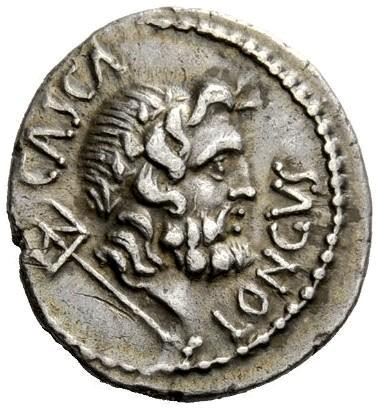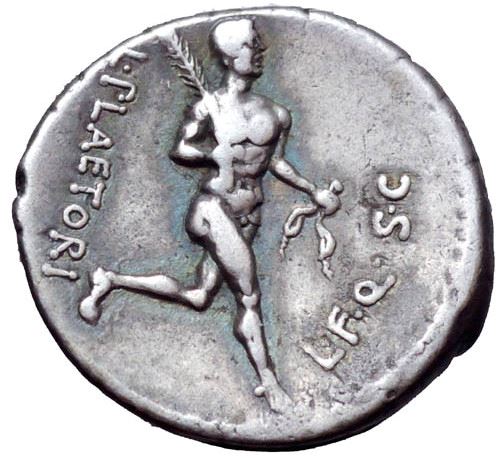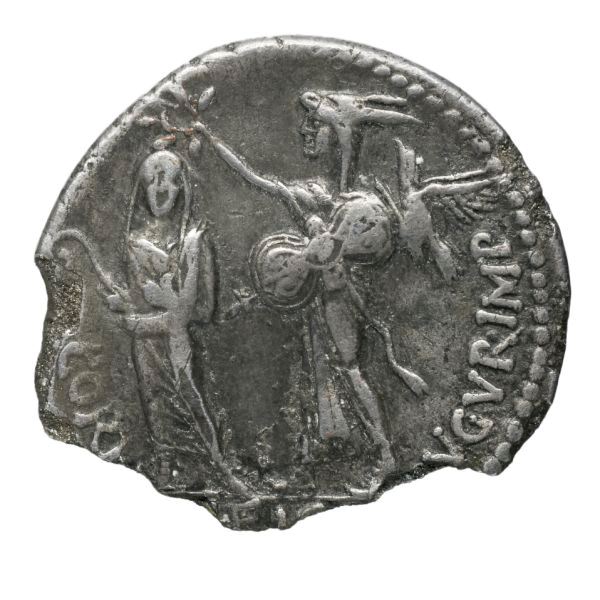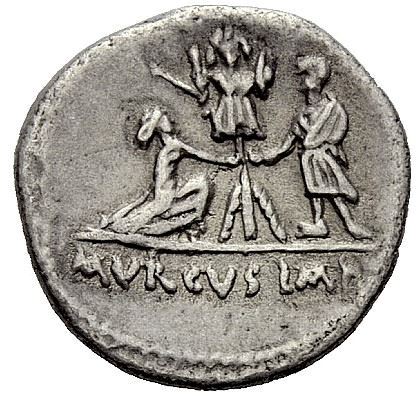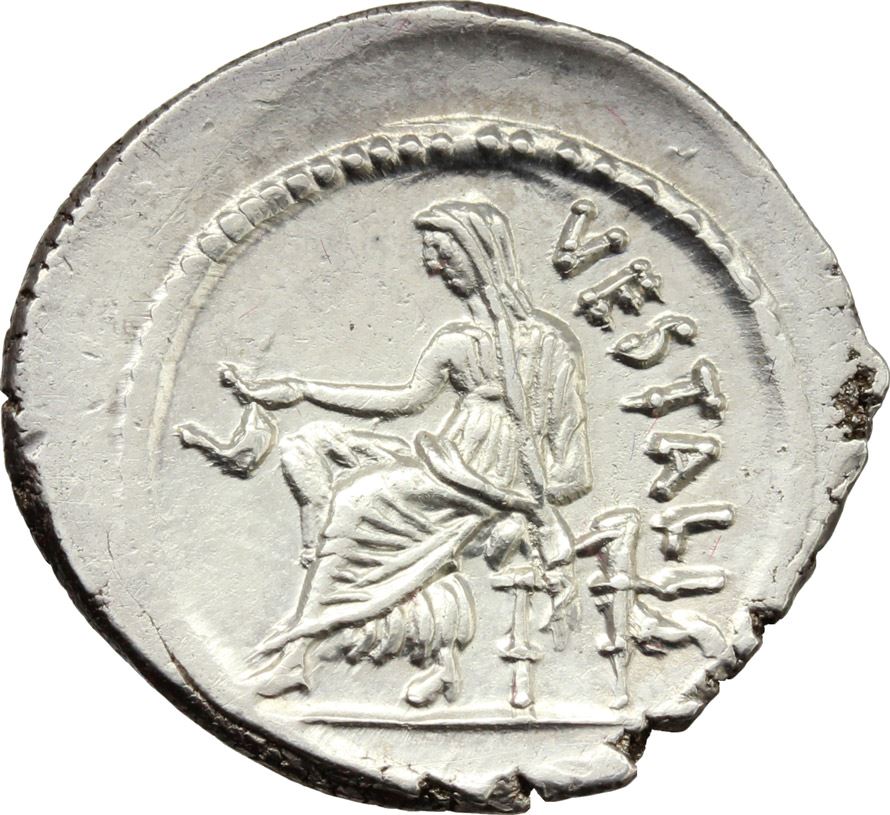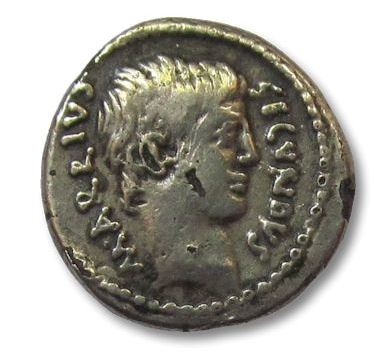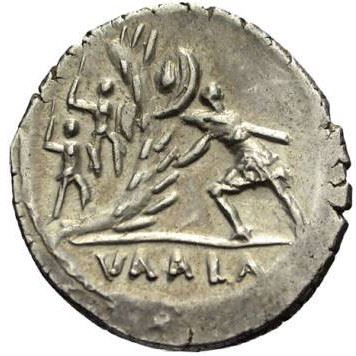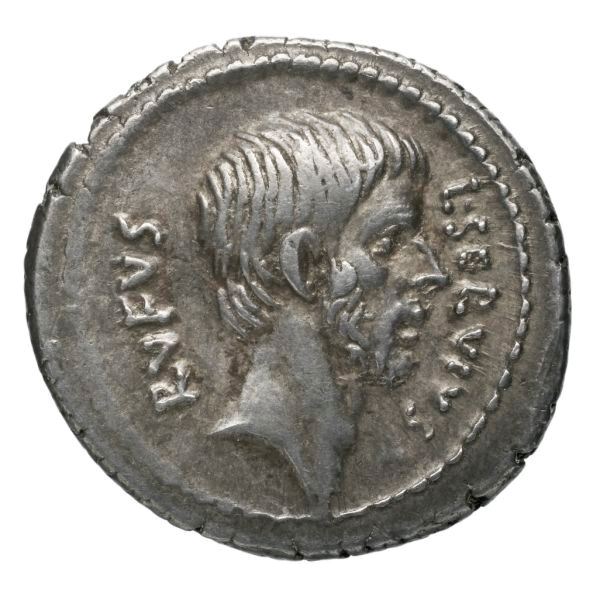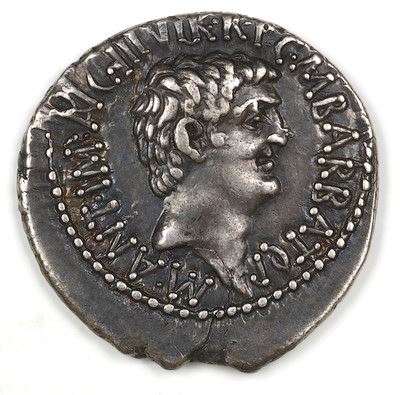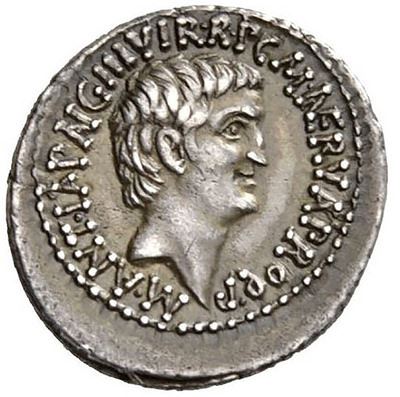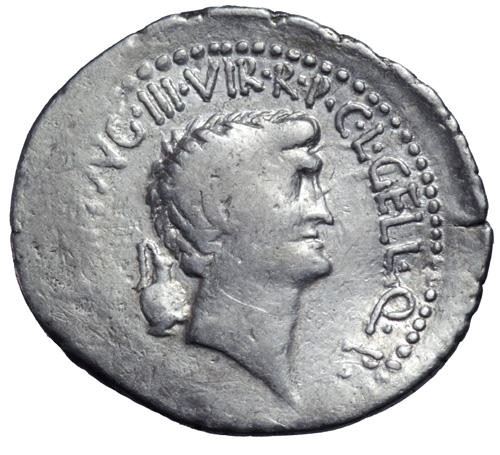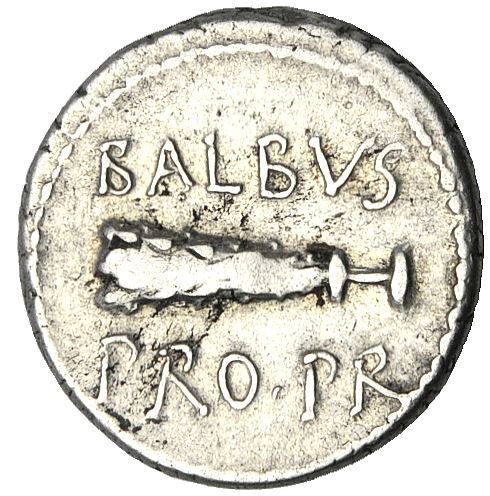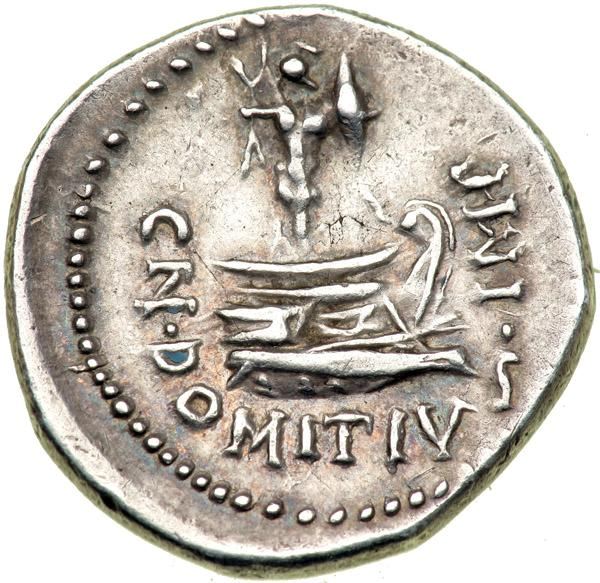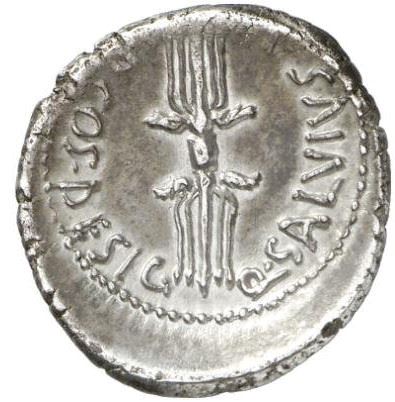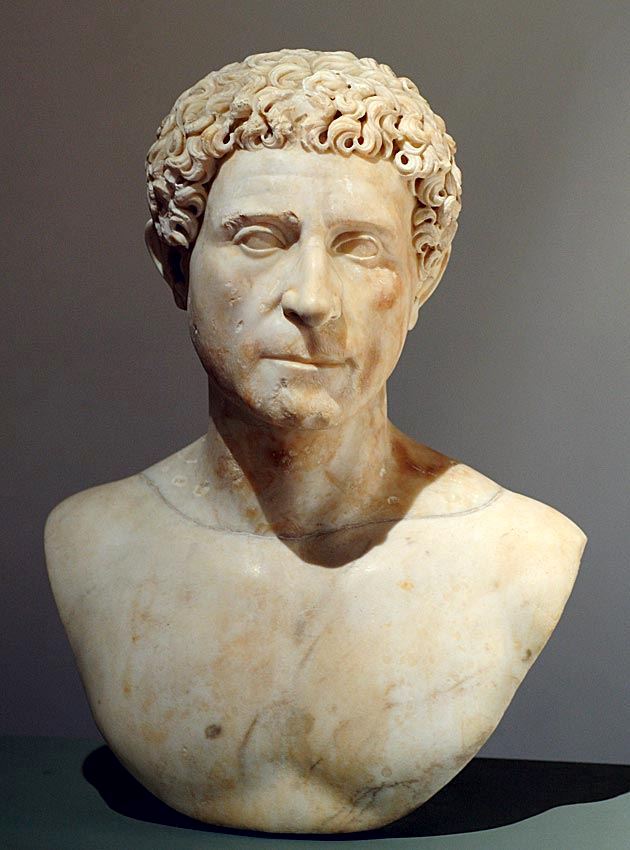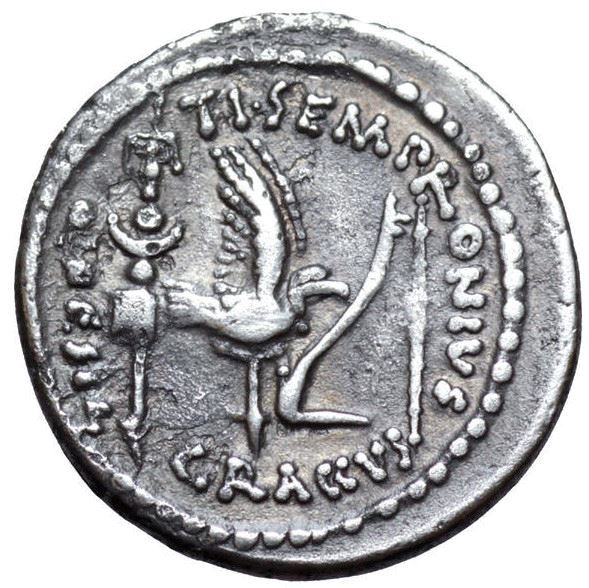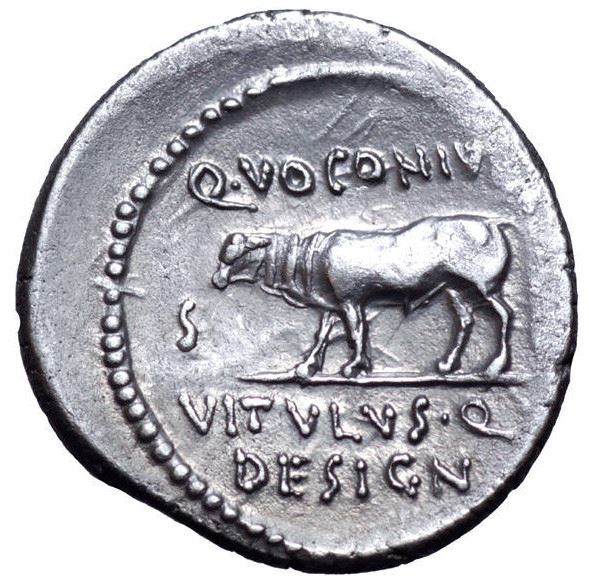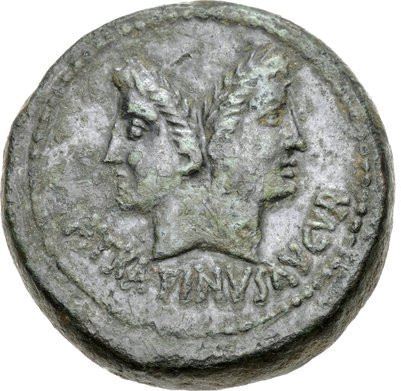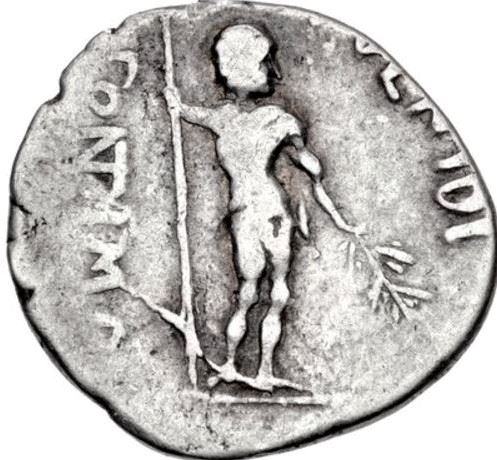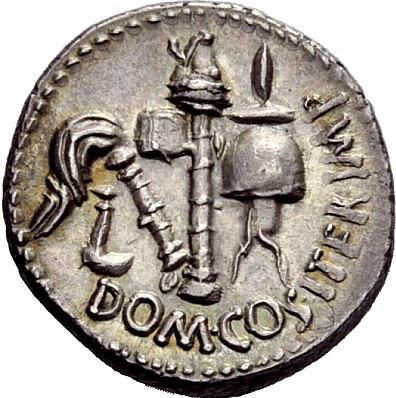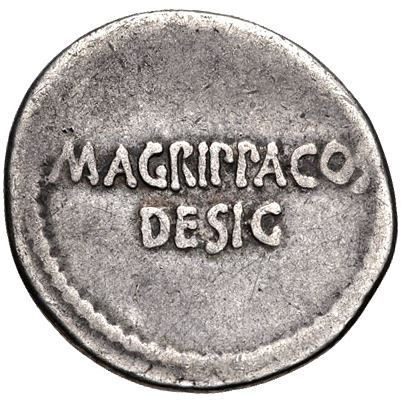This category covers the coins minted from the Ides of March in 44 BC and until the defeat of Sextus Pompey and the fall of Lepidus in 35 BC.
While the official coins of the late Republic were still minted under the control of the moneyers, it became more and more common practice for imperators to coin their own money to pay their troops and for propaganda purposes.
While the official coins of the late Republic were still minted under the control of the moneyers, it became more and more common practice for imperators to coin their own money to pay their troops and for propaganda purposes.
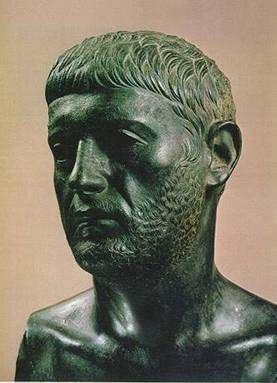
Q. Nasidius was one of the admirals of Gnaeus Pompeius Magnus during the Civil War. A coin dated to 44-43 BC was struck by him, featuring the head of Pompeius and a trident on the obverse, and on the reverse a ship, with the inscription Q. Nasidius.
Gens Nasidia was otherwise an obscure plebeian family. Although none of the Nasidii are known to have held any of the higher offices of th...
Gens Nasidia was otherwise an obscure plebeian family. Although none of the Nasidii are known to have held any of the higher offices of th...
L. Flaminius Chilo was one of the moneyers for the year 43 BC. He is not otherwise known, but must have been a supporter of Caesar, given his coinage.
Interestingly, Flaminius Chilo was a quattrovir monetalis - as Caesar had added a fourth member to the triumvirate in charge of striking coins, and also given them the liberty of striking gold coins.
Gens Flaminia was a plebeia...
Interestingly, Flaminius Chilo was a quattrovir monetalis - as Caesar had added a fourth member to the triumvirate in charge of striking coins, and also given them the liberty of striking gold coins.
Gens Flaminia was a plebeia...
P. Accoleius Lariscolus was one of the moneyers for the year 43 BC. He is not otherwise known.
Gens Accoleia, also spelled Acculeia, Acoleia, or Aculeia was a minor plebeian family at Rome during the first century BC. Most of what is known of the family comes from various coins and inscriptions.
The origin of the nomen is obscure, but the gens apparently shared its name with ...
Gens Accoleia, also spelled Acculeia, Acoleia, or Aculeia was a minor plebeian family at Rome during the first century BC. Most of what is known of the family comes from various coins and inscriptions.
The origin of the nomen is obscure, but the gens apparently shared its name with ...
Petillius Capitolinus was one of the moneyers for the year 43 BC. He is not otherwise known.
Gens Petillia or Petilia was a plebeian family at ancient Rome. Members of this gens first appear in history at the beginning of the second century BC, and the first to obtain the consulship was Quintus Petillius Spurinus in 176 BC.
The nomen is almost certainly derived from the cogno...
Gens Petillia or Petilia was a plebeian family at ancient Rome. Members of this gens first appear in history at the beginning of the second century BC, and the first to obtain the consulship was Quintus Petillius Spurinus in 176 BC.
The nomen is almost certainly derived from the cogno...
Marcus Antonius was a politician and general who played a critical role in transforming the Roman Republic from an oligarchy into an Empire.
As a supporter of Julius Caesar, he served as one of his generals during the conquest of Gaul and the Civil War. After Caesar's death in 44 BC, Antonius joined forces with Lepidus and Octavian to form the 2nd Triumvirate.
Relations among...
As a supporter of Julius Caesar, he served as one of his generals during the conquest of Gaul and the Civil War. After Caesar's death in 44 BC, Antonius joined forces with Lepidus and Octavian to form the 2nd Triumvirate.
Relations among...
Marcus Aemilius Lepidus was triumvir with Octavian and Marcus Antonius and served as the last Pontifex Maximus of the Roman Republic. He had previously been a close ally of Julius Caesar.
Though an able commander, Lepidus has always been portrayed as the weakest triumvir. After losing the power struggle to Octavian, he was stripped of all offices except that of Pontifex Maximus and sent...
Though an able commander, Lepidus has always been portrayed as the weakest triumvir. After losing the power struggle to Octavian, he was stripped of all offices except that of Pontifex Maximus and sent...
L. Cestius was one of the moneyers for the year 43 BC, and struck coins alongside C. Norbanus Flaccus.
Gens Cestia was a plebeian family at Rome during the later Republic, and in imperial times. The first member of the gens to obtain the consulship was Gaius Cestius Gallus in AD 35. The family's name is commemorated on two monuments, the Pons Cestius and the Pyramid of Cestius which sur...
Gens Cestia was a plebeian family at Rome during the later Republic, and in imperial times. The first member of the gens to obtain the consulship was Gaius Cestius Gallus in AD 35. The family's name is commemorated on two monuments, the Pons Cestius and the Pyramid of Cestius which sur...
Gaius Norbanus Flaccus was a Roman politician and general during the 1st century BC. He struck coins jointly with L. Cestius in 43 BC, a year where he also served as Praetor.
Flaccus was the grandson of Gaius Norbanus, moneyer for the year 83 BC. His family had suffered under the proscriptions of Lucius Cornelius Sulla, but had found favour under the regime of Julius Caesar. With Caesar...
Flaccus was the grandson of Gaius Norbanus, moneyer for the year 83 BC. His family had suffered under the proscriptions of Lucius Cornelius Sulla, but had found favour under the regime of Julius Caesar. With Caesar...
L. Livineius Regulus was one of the moneyers for the year 42 BC. He was one of four moneyers, during the relatively short period of time where the triumvirate of moneyers was extended with a fourth member.
Gens Livineia is known only from the moneyer, and from his father who was probably Praetor some 10 years before, and who is believed to be featured on the issues of his son.
Gens Livineia is known only from the moneyer, and from his father who was probably Praetor some 10 years before, and who is believed to be featured on the issues of his son.
P. Clodius M.f. Turrinus was one of the moneyers for the year 42 BC. He is not otherwise known.
Clodius is an alternate form of the Roman nomen Claudius, a patrician gens that was traditionally regarded as Sabine in origin. The alternation of o and au is characteristic of the Sabine dialect.
In the Late Republic, the spelling Clodius is most prominently associated with Publiu...
Clodius is an alternate form of the Roman nomen Claudius, a patrician gens that was traditionally regarded as Sabine in origin. The alternation of o and au is characteristic of the Sabine dialect.
In the Late Republic, the spelling Clodius is most prominently associated with Publiu...
C. Vibius Varus was one of the moneyers for the year 42 BC. He is not otherwise known.
Gens Vibia was a minor plebeian family which first appears after the Second Punic War. The first member to attain the consulship was C. Vibius Pansa Caetronianus in 43 BC.
The cognomen 'Varus' means 'bow-legged'. I could have been a family name, or perhaps a personal name.
Gens Vibia was a minor plebeian family which first appears after the Second Punic War. The first member to attain the consulship was C. Vibius Pansa Caetronianus in 43 BC.
The cognomen 'Varus' means 'bow-legged'. I could have been a family name, or perhaps a personal name.
L. Mussidius Longus was one of the four moneyers for the year 42 BC, appointed by the triumvirs of the 2nd Triumvirate.
Gens Mussidia was a minor plebeian family at Rome. Few of its members are known to have attained the higher offices of the Roman state, and the gens is best known from inscriptions.
The only cognomen associated with the main branch of the Mussidii is Longus,...
Gens Mussidia was a minor plebeian family at Rome. Few of its members are known to have attained the higher offices of the Roman state, and the gens is best known from inscriptions.
The only cognomen associated with the main branch of the Mussidii is Longus,...
M. Aquinus was Legatus from 43-42 BC, and struck a number of issues jointly with C. Cassius Longinus in that respect. He and his gens is not otherwise known.
A legatus was a high ranking Roman military office in the Roman army, equivalent to a modern high ranking general officer. Initially used to delegate power, the term became formalized under Augustus as the officer in command of a ...
A legatus was a high ranking Roman military office in the Roman army, equivalent to a modern high ranking general officer. Initially used to delegate power, the term became formalized under Augustus as the officer in command of a ...
Caius Cassius Longinus was a Roman senator, a leading instigator of the plot to kill Julius Caesar, and the brother in-law of Marcus Junius Brutus.
He commanded troops with Brutus during the Battle of Philippi against the combined forces of Mark Antony and Octavian, Caesar's former supporters, and committed suicide after being defeated by Mark Antony.
He followed the teaching...
He commanded troops with Brutus during the Battle of Philippi against the combined forces of Mark Antony and Octavian, Caesar's former supporters, and committed suicide after being defeated by Mark Antony.
He followed the teaching...
L. Cornelius Lentulus Spinther was one of the moneyers for the year 43-42 BC. He served as Quaestor in 44 BC. He struck a series of issues jointly with C. Cassius Longinus and M. Junius Brutus.
Gens Cornelia was one of the greatest patrician houses at Rome. For more than seven hundred years, from the early decades of the Republic to the third century AD, the Cornelii produced more emine...
Gens Cornelia was one of the greatest patrician houses at Rome. For more than seven hundred years, from the early decades of the Republic to the third century AD, the Cornelii produced more emine...
Lucius Sestius Quirinalis Albinianus was an aristocrat of the late Roman Republic. Although having Republican tendencies, Augustus appointed him suffect consul in 23 BC to fill his role. He struck coins in 43-42 BC, in a role as proquaestor for M. Junius Brutus.
Gens Sestia was a family at Rome. The gens was originally patrician, but in later times there were also plebeian members. The ...
Gens Sestia was a family at Rome. The gens was originally patrician, but in later times there were also plebeian members. The ...
C. Flavius Hemicullus was legatus propraetor in 43-42 BC, and in that role struck coins jointly with M. Junius Brutus.
Gens Flavia was a plebeian family at Rome. Its members are first mentioned during the last three centuries of the Republic. The first of the Flavii to achieve prominence was Marcus Flavius, Tribune of the plebs in 327 and 323 BC; however, no Flavius attained the consuls...
Gens Flavia was a plebeian family at Rome. Its members are first mentioned during the last three centuries of the Republic. The first of the Flavii to achieve prominence was Marcus Flavius, Tribune of the plebs in 327 and 323 BC; however, no Flavius attained the consuls...
C. Flavius Hemic was Legatus in 43-42 BC, and struck coins in that role jointly with C. Cassius Longinus and M. Junius Brutus.
Gens Servilia was a patrician family at Rome. The gens was celebrated during the early ages of the Republic, and the names of few gentes appear more frequently at this period in the consular Fasti. It continued to produce men of influence in the state down to th...
Gens Servilia was a patrician family at Rome. The gens was celebrated during the early ages of the Republic, and the names of few gentes appear more frequently at this period in the consular Fasti. It continued to produce men of influence in the state down to th...
Pedanius Costa was a Legatus in 43-42 BC who struck coins jointly with M. Junius Brutus.
Gens Pedania was a minor plebeian family at Rome. Members of this gens are first mentioned at the time of the Second Punic War, but they achieved little prominence until imperial times, when the ill-starred Lucius Pedanius Secundus attained the consulship under Nero.
The great majority of...
Gens Pedania was a minor plebeian family at Rome. Members of this gens are first mentioned at the time of the Second Punic War, but they achieved little prominence until imperial times, when the ill-starred Lucius Pedanius Secundus attained the consulship under Nero.
The great majority of...
Publius Servilius Casca Longus was was one of the assassins of Gaius Julius Caesar. Afterwards, Casca fought with the liberators during the Liberators' civil war. He is believed to have died by suicide after their defeat at the Battle of Philippi in 42 BC. He struck coins as Legatus jointly with Brutus between 43 and 42 BC.
Gens Servilia was a patrician family at Rome. The gens was cele...
Gens Servilia was a patrician family at Rome. The gens was cele...
L. Plaetorius Cestianus struck coins jointly with M. Junius Brutus in 43-42 BC. He was Quaestor in 42 BC.
Gens Plaetoria was a plebeian family at Rome. A number of Plaetorii appear in history during the first and second centuries BC, but none of this gens ever obtained the consulship. Several Plaetorii issued denarii from the late 70s into the 40s, of which one of the best known alludes...
Gens Plaetoria was a plebeian family at Rome. A number of Plaetorii appear in history during the first and second centuries BC, but none of this gens ever obtained the consulship. Several Plaetorii issued denarii from the late 70s into the 40s, of which one of the best known alludes...
Q. Cornuficius was struck coins as a commander on the republican side of the civil war in 42 BC, but the symbolism seems confined to his augurate, his origin, and the province of Africa.
Gens Cornificia was a plebeian family at Rome. No persons of this name occur until the last century of the Republic; and the first who obtained any of the higher honours of the state was Quintus Cornifi...
Gens Cornificia was a plebeian family at Rome. No persons of this name occur until the last century of the Republic; and the first who obtained any of the higher honours of the state was Quintus Cornifi...
L. Staius Murcus was a Legatus which struck coins in 42 BC. He served under Caesar in Gaul and Africa, and was present at the Senate House on the Ides of March and whilst he did not participate in Caesar’s murder, he approved of the deed. He was Praetor in 45 BC.
After Caesar was assassinated, the Senate sent Murcus to Syria as proconsul to help Cassius besiege Q. Caecilius Bassus. He ...
After Caesar was assassinated, the Senate sent Murcus to Syria as proconsul to help Cassius besiege Q. Caecilius Bassus. He ...
C. Clodius Vestalis was one of the moneyers for the year 41 BC. He is not otherwise known.
Clodius is an alternate form of the Roman nomen Claudius, a patrician gens that was traditionally regarded as Sabine in origin. The alternation of o and au is characteristic of the Sabine dialect.
In the Late Republic, the spelling Clodius is most prominently associated with Publius Cl...
Clodius is an alternate form of the Roman nomen Claudius, a patrician gens that was traditionally regarded as Sabine in origin. The alternation of o and au is characteristic of the Sabine dialect.
In the Late Republic, the spelling Clodius is most prominently associated with Publius Cl...
Marcus Arrius Secundus was one of the moneyers for the year 41 BC. He is not otherwise known.
Gens Arria was a plebeian family at Rome, which appears in the first century BC, and became quite large in imperial times. The first of the gens to achieve prominence was Quintus Arrius, praetor in 72 BC.
Gens Arria was a plebeian family at Rome, which appears in the first century BC, and became quite large in imperial times. The first of the gens to achieve prominence was Quintus Arrius, praetor in 72 BC.
Caius Numonius Vaala was one of the moneyers for the year 41 BC. He is not otherwise known.
Gens Numonia, occasionally written Nummonia, was a minor plebeian family at Rome. Members of this gens are first mentioned in the early years of the Empire. Few if any of the Numonii held any Roman magistracies.
The only distinct family of the Numonia gens bore the surname Vala, also s...
Gens Numonia, occasionally written Nummonia, was a minor plebeian family at Rome. Members of this gens are first mentioned in the early years of the Empire. Few if any of the Numonii held any Roman magistracies.
The only distinct family of the Numonia gens bore the surname Vala, also s...
L. Servius Rufus was one of the moneyers for the year 41 BC. He is not otherwise known.
Gens Servia is virtually unattested, and coins of this moneyer are registered by Crawford undet the Sulpicii.
Gens Servia is virtually unattested, and coins of this moneyer are registered by Crawford undet the Sulpicii.
M. Barbatius Pollio held the unusual office Quaestor Pro Praetore in the east in 41-40 BC. He accompanied Marcus Antonius after the battle of Philippi. He was probably also Curule Aedile.
He restored aedicula shrine on the Forum Romanum and fountain of goddess Juturna (Lacus Iuturnae).
A provincial quaestor normally acted as subordinate to a governor. If the governor of a pr...
He restored aedicula shrine on the Forum Romanum and fountain of goddess Juturna (Lacus Iuturnae).
A provincial quaestor normally acted as subordinate to a governor. If the governor of a pr...
Marcus Cocceius Nerva struck coins as Proquaestor pro praetore under Antonius in 41 BC, jointly with Antonius and others, and it is assumed that he was with Lucius Antonius during the Perusine War.
He was one of the key military officers in Antonius's army who refused to fight Octavianus and brought about the reconciliation between the two men in 40 BC. Around 38 BC, Marcus Antonius app...
He was one of the key military officers in Antonius's army who refused to fight Octavianus and brought about the reconciliation between the two men in 40 BC. Around 38 BC, Marcus Antonius app...
Lucius Gellius Publicola struck coins in 41 BC, jointly with Marcus Antonius and a number of other people.
Gens Gellia was a plebeian family at ancient Rome, where they settled after the Second Punic War. The first of the Gellii to obtain the consulship was Lucius Gellius Poplicola, consul in 72 BC, but the most famous member of this gens is probably the grammarian Aulus Gellius, who fl...
Gens Gellia was a plebeian family at ancient Rome, where they settled after the Second Punic War. The first of the Gellii to obtain the consulship was Lucius Gellius Poplicola, consul in 72 BC, but the most famous member of this gens is probably the grammarian Aulus Gellius, who fl...
Lucius Cornelius Balbus was a wealthy Roman politician and businessman from Gades who played a significant role in the emergence of the Principate at Rome. He was a prominent supporter of Julius Caesar and an intimate advisor to the emperor Augustus. He struck coins as for Caesar with Octavian in 41 BC.
He served in Hispania under Pompey and Metellus Pius against Sertorius. For his serv...
He served in Hispania under Pompey and Metellus Pius against Sertorius. For his serv...
Cn. Domitius L.f. Ahenobarbus was a general and politician in the 1st century BC. He struck coins in 42 BC, both alone and with Marcus Antonius.
In 42 BC he commanded a Republican fleet of fifty ships in the Ionian sea, and gained considerable success against the Second Triumvirate, completely defeating Gnaeus Domitius Calvinus on the day of the first battle of Philippi, as the latter a...
In 42 BC he commanded a Republican fleet of fifty ships in the Ionian sea, and gained considerable success against the Second Triumvirate, completely defeating Gnaeus Domitius Calvinus on the day of the first battle of Philippi, as the latter a...
Quintus Salvidienus Rufus was a Roman general and one of the closest advisors of Octavian during the early years of his political activity. He struck coins in 40 BC in the name of Julius Caesar, in conjunction with Octavian.
In 42 BC he commanded the fleet of Octavian against Sextus Pompeius, who had taken control of Sicily and was harassing the coasts of Italy. However, Salvidienus wa...
In 42 BC he commanded the fleet of Octavian against Sextus Pompeius, who had taken control of Sicily and was harassing the coasts of Italy. However, Salvidienus wa...
Quintus Labienus Parthicus was a Roman republican general, later in the service of Parthia. He struck coins in 40 BC as Imperator.
After Julius Caesar was murdered by a conspiracy in 44 BC, Labienus took the side of the pro-republic conspirators, led by Brutus and Cassius, the latter of whom he served in the capacity of an ambassador to the Parthians. After Brutus and Cassius fled east ...
After Julius Caesar was murdered by a conspiracy in 44 BC, Labienus took the side of the pro-republic conspirators, led by Brutus and Cassius, the latter of whom he served in the capacity of an ambassador to the Parthians. After Brutus and Cassius fled east ...
Ti. Sempronius Gracchus was one of the moneyers for the year 40 BC, as well as Quaestor Designatum.
Gens Sempronia was a Roman family of great antiquity. It included both patrician and plebeian branches. The first of the Sempronii to obtain the consulship was Aulus Sempronius Atratinus, in 497 BC, the twelfth year of the Republic. The patrician Sempronii frequently obtained the highest...
Gens Sempronia was a Roman family of great antiquity. It included both patrician and plebeian branches. The first of the Sempronii to obtain the consulship was Aulus Sempronius Atratinus, in 497 BC, the twelfth year of the Republic. The patrician Sempronii frequently obtained the highest...
Q. Voconius Vitulus was one of the moneyers for the year 40 BC, as well as Quaestor Designatum.
Gens Voconia was a minor gens about whom very little is known. A Lex Voconia was introduced in 169 BC by Q. Voconius Saxa with support from Cato the Elder. It prohibited those who owned property valued at 100,000 asses (or perhaps sesterces) from making a woman their heir.
This par...
Gens Voconia was a minor gens about whom very little is known. A Lex Voconia was introduced in 169 BC by Q. Voconius Saxa with support from Cato the Elder. It prohibited those who owned property valued at 100,000 asses (or perhaps sesterces) from making a woman their heir.
This par...
Lucius Sempronius Atratinus was a Roman politician who was elected suffect consul in 34 BC. He struck coins c. 39 BC as Augur and jointly with Marcus Antonius.
In 56 BC he launched a prosecution against Marcus Caelius Rufus who had previously unsuccessfully attempted to prosecute Atratinus’s adopted father on bribery charges. Caelius had fallen out with his lover, Clodia, and she accuse...
In 56 BC he launched a prosecution against Marcus Caelius Rufus who had previously unsuccessfully attempted to prosecute Atratinus’s adopted father on bribery charges. Caelius had fallen out with his lover, Clodia, and she accuse...
Publius Ventidius Publii filius Bassus was a Roman general and one of Julius Caesar's protégés. He struck coins as Imperator in 39 BC in conjunction with Marcus Antonius.
He won impressive victories against the Parthians which resulted in the deaths of key leaders - victories which redeemed the losses of Crassus and paved the way for Antony's incursions.
After peace was concl...
He won impressive victories against the Parthians which resulted in the deaths of key leaders - victories which redeemed the losses of Crassus and paved the way for Antony's incursions.
After peace was concl...
Cnaeus Domitius M.f. M.n. Calvinus was a Roman general, senator and consul (both in 53 BC and 40 BC) who was a loyal partisan of Caesar and Octavianus. He struck coins as Imperator in 39 BC.
Domitius Calvinus's activities after the death of Caesar are unknown, but in 43 BC he was a strong supporter of Octavianus and participated in the civil war against Brutus and Cassius. During the Ph...
Domitius Calvinus's activities after the death of Caesar are unknown, but in 43 BC he was a strong supporter of Octavianus and participated in the civil war against Brutus and Cassius. During the Ph...
Marcus Vipsanius Agrippa was a Roman consul, statesman, general and architect. He struck an issue in 38 BC jointly with Octavian, but was also honoured posthumously during imperial times.
He was a close friend, son-in-law, and lieutenant to Octavian and was responsible for the construction of some of the most notable buildings in the history of Rome and for important military victories,...
He was a close friend, son-in-law, and lieutenant to Octavian and was responsible for the construction of some of the most notable buildings in the history of Rome and for important military victories,...

